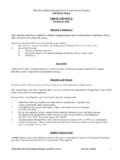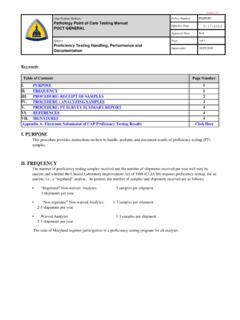Transcription of URINE DIPSTICK Multistix® 10SG Operator Competency
1 Copyright 2005 Johns Hopkins Hospital All rights reserved Revision: 10/2010 1 The Johns Hopkins Hospital Point-of-Care Testing Program Self-Study Packet URINE DIPSTICK multistix 10SG Operator Competency Only operators who have completed a defined training program and can demonstrate competence will be able to perform URINE DIPSTICK testing. Operator Competency will be assessed annually by two methods. a. Successful performance of quality control (Quantimetrix Dropper Plus Level 1 and Level 2) b. One of the following: Testing an unknown specimen Having the supervisor or qualified delegate periodically observe routine work Written test Test Order A physician s order, standard protocol, or order by other health professionals authorized to request laboratory tests i s required for URINE DIPSTICK testing. Reagents and Storage The Siemens URINE DIPSTICK bottles and URINE Controls are to be dated when initially opened.
2 The Opened Date and New Expiration Date are to be recorded on the Quantimetrix Dropper Plus URINE Control bottles when stored at room temperature. Do not use the URINE Dipsticks and URINE Controls after the expiration date. 1. multistix 10SG URINE dipsticks are stable until the manufacturer s expiration date printed on the bottle when stored properly. 2. URINE dipsticks are stored in the original, tightly sealed bottle at room temperature (15-30oC or 59-86oF). 3 Do not store dipsticks in direct sunlight. Protect dipsticks from heat sources and light exposure. 4. The Quantimetrix Dropper Plus URINE Controls are stable for one month at room temperature (18-25 C or 64-77 F). Do not store above 30 C (86 F). 5. The Quantimetrix Dropper Plus URINE Controls can also be stored at 2-8 C (35-46 F) in a temperature monitored refrigerator. When stored refrigerated, the URINE Controls are stable until the expiration date stated on the label.
3 Do not freeze. Quality Control Label A JHMI Quality Control label should be affixed to the bottle of URINE dipsticks when it is first opened. Record the open date at the top of the QC label in the space below Date Opened . Copyright 2005 Johns Hopkins Hospital All rights reserved Revision: 10/2010 2 The Johns Hopkins Hospital POCT Program Self-Study Packet URINE DIPSTICK - multistix 10SG Quality Control Frequency 1. Weekly on each opened bottle of URINE dipsticks. 2. Each time a new bottle of URINE dipsticks is opened. Quality Control 1. Record the lot number and expiration dates of the URINE dipsticks and controls on the URINE DIPSTICK QC log sheet, along with the date, time and Operator initials. 2. Ensure that the control solutions are at room temperature before use. 3. Test the control solutions (Level 1 and Level 2) by squeezing the control bottle and drawing the control solution across all of the reagent pads, thoroughly saturating each pad.
4 Do not aspirate excess control back into the bottle. Drain excess from DIPSTICK . Time appropriately. 4. Record control results on the URINE DIPSTICK QC Log. Record results in the units specified on the URINE DIPSTICK bottle. 5. Note any QC failures and corrective action taken on the URINE DIPSTICK QC Log. 6. If both levels of controls are within the acceptable ranges, record the date and Operator initials on the JHMI QC label affixed to the reagent strip bottle. This bottle may be used for one week for patient testing. Quality Control Results Documentation Summary 1. Record date, time, Operator initials and lot numbers of dipsticks and controls on log sheet. 2. Record the Quality Control results in the units specified on the bottle of URINE dipsticks. 3. Do not use + or for results (example: Record blood as 3+ not +++, NEG/negative, POS/positive) 4. Place a mark in the QC Pass/Fail Column to note whether QC passed or failed.
5 5. Document any QC failures and corrective actions on the URINE DIPSTICK QC log sheet Quality Control Failures and Corrective Actions If one or more of the URINE control solutions fail to give expected results: 1. Check to make sure that the control solutions and URINE dipsticks have not expired. 2. Repeat test. 3. If the repeat test fails, open a new set of URINE controls and repeat. 4. If this test fails using the new controls, open a new bottle of URINE dipsticks and repeat. 5. If the repeat test fails using the newly opened bottle of dipsticks and controls, STOP PATIENT TESTING AND REPORTING OF PATIENT RESULTS until the quality control issues are resolved and the expected results are obtained and recorded. 6. Document all steps taken in the Comment Section of the URINE DIPSTICK QC Log sheet. 7. Contact the POCT Program Office for assistance. Copyright 2005 Johns Hopkins Hospital All rights reserved Revision: 10/2010 3 The Johns Hopkins Hospital POCT Program Self-Study Packet URINE DIPSTICK - multistix 10SG Specimen Collection 1.
6 Use at least 2 unique patient identifiers (neither to be the patient s room number) to verify a patient s identity when collecting samples for testing. 2. Label the URINE container (not the lid) with the patient identifiers. 3. Samples must be fresh (not refrigerated) and tested promptly within 1 hour of collection. 4. Gloves must be worn during sample collection and testing (Standard Precautions). Patient Testing 1. Check the JHMI QC label on the bottle of URINE dipsticks or the URINE DIPSTICK QC log sheet to make sure that quality control has been performed for the week. If not, stop and perform QC before doing any patient tests. 2. Remove a test strip from the bottle of URINE dipsticks. Recap the bottle before proceeding. 3. Gently swirl the URINE container in order to thoroughly mix the URINE . 4. Immerse the pads on the DIPSTICK in the URINE sample and remove immediately.
7 5. While removing the strip from the URINE container, wipe the edge of the DIPSTICK on the container rim to remove excess URINE . 6. Hold the DIPSTICK level to avoid mixing reagents from adjacent pads. 7. Hold the DIPSTICK near the color chart on the bottle of dipsticks and read in the order and at the time intervals specified in the attached Interpretation Chart. The glucose pad is nearest the hand- held end of the DIPSTICK . Color changes that occur after the correct reading time are erroneous. 8. Record the patient s results, along with the date, time and Operator initials on the chart, EPR or flow sheet. 9. When documenting the results in the patient s chart, place a check mark ( ) or QC okay next to the results to indicate that Quality control has successfully been run within one week. 10. Results should be noted as Point-of-Care Testing results in order to distinguish them from laboratory results.
8 11. Dispose of URINE samples in toilet when testing is finished. 12. Discard used test strips in a JHMI approved biohazard container Patient Result Reporting 1. Record all URINE DIPSTICK test results, including negative results, with the date, time, Operator initials and care actions in the patient chart. 2. Record the patient results in the reporting units specified on the bottle of URINE dipsticks. 3. Do not use (+) or ( ) signs to report positive and negative results. Record negative results as Neg or Negative and positive results as Pos or Positive . 4. Record a +++ result as 3+, a ++ result as 2+, etc. 5. Place a check mark ( ) or QC okay next to the patient results to indicate that external Quality Control had been successfully run within the previous week on the bottle of dipsticks used. 6. Note the results as Point-of-Care results to differentiate results from central laboratory results.
9 Copyright 2005 Johns Hopkins Hospital All rights reserved Revision: 10/2010 4 The Johns Hopkins Hospital POCT Program Self-Study Packet URINE DIPSTICK - multistix 10SG Abnormal Results 1. Abnormal results are defined as: a. Any value greater than negative/normal for glucose, bilirubin, ketones, protein, urobilinogen, blood, nitrite or leukocytes. b. Both the normal and abnormal urinary pH range is c. Random urines may vary in specific gravity from 2. Questionable URINE DIPSTICK results, problems with the testing procedure or results that do not match the clinical condition should be reported to the physician/provider to determine if additional follow-up is needed, repeat the point-of-care test, send a sample to the core laboratory etc. 3. In the event of abnormal or questionable URINE DIPSTICK results, document in the patient s record that the physician/provider has been notified.
10 Critical Action Value 1. Ketones: Large amount (80-160 mg/dL) 2. Notify the patient s physician/provider to determine if additional follow-up is needed. 3. Document in the patient s record that the physician/provider was notified and that a read-back of the Critical Action Value occurred and was verified. Copyright 2005 Johns Hopkins Hospital All rights reserved Revision: 10/2010 5 The Johns Hopkins Hospital POCT Program Self-Study Packet URINE DIPSTICK - multistix 10SG INTERPRETATION CHART FOR URINE DIPSTICK RESULTS: Results are read and recorded as follows: Test Read at Test Interpretation Glucose 30 seconds Negative, 1/10 (tr) g/dL, g/dL, g/dL, 1 g/dL, 2 or more g/dL OR Negative, 100 mg/dL, 250 mg/dL, 500 mg/dL, 1000 mg/dL, 2000 or more mg/dL Bilirubin 30 seconds Negative, Small, Moderate, Large OR Negative, 1+, 2+, 3+ Ketone 40 seconds Negative, Trace, Small, Moderate, Large OR Negative, 5mg/dL, 15 mg/dL, 40 mg/dL, 80 mg/dL, 100 mg/dL specific gravity 45 seconds * For increased specific gravity accuracy, is added to readings from urines with pH equal to or greater than Blood 60 seconds Negative, Trace, Small, Moderate, Large OR Negative, Trace, 1+, 2+, 3+ pH 60 seconds , , , , , , Protein 60 seconds Negative, Trace, 30 mg/dL, 100 mg/dL, 300 mg/dL, over 2000 mg/dL OR Negative, Trace, 1+, 2+, 3+, 4+ Urobilinogen 60 seconds mg/dL, 1 mg/dL, 2mg/dL, 4 mg/dL.




